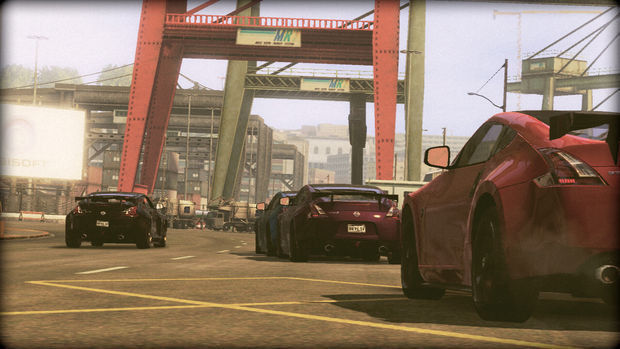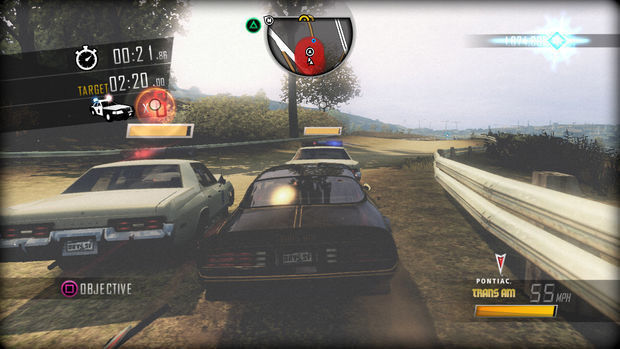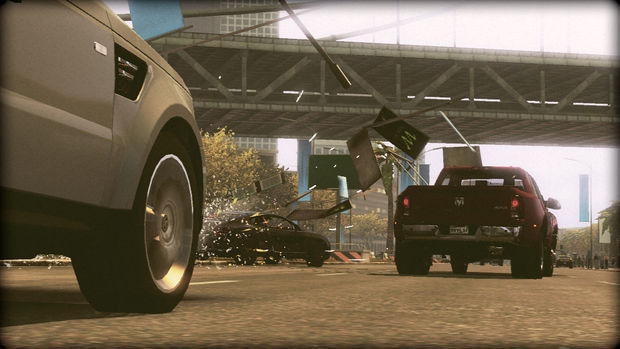Driver's main problem stems from the lack of evolution. Putting it bluntly, the game feels old and archaic. Almost immediately, players will be plunged into a high speed chase that results in lead character John Tanner laying on his deathbed, prisoner to the confines of a coma.. Luckily for him, Tanner witnesses more than light at the end of the tunnel. In fact, his crash has turned him into a detective who can not only swap between looking into the minds of others, he can manipulate them to capture Jericho, a ballsy felon. It's through this narrative that Ubisoft include their new gameplay element, as players get the chance to explore the city through a thousand different eyes.
 |
| Is that the Golden Gat...no |
While this idea may seem impressive, it takes a while to show itself as anything other than a portal between missions. Each objective is simple, and pits players amidst high-speed cop chases (on both sides of the law), the filming of stunts for an upcoming movie production, and delivering precious payloads. Tanner's body-swapping antics come in handy, as he's able to get a one-up on the criminals he's trying to catch by squeezing information out of their unsuspecting accomplices. He even has the chance to live on the wild side, entering do or die street races, throwing cars over giant jumps, and generally causing havoc without the consequences.
At one point, Tanner takes control of a boyfriend who doesn't realise he is being cheated on by his criminal lover. Quickly evading the cops, Tanner rushes her to a designated getaway point. Unfortunately for the real driver, the cunning broad reveals that she's running off with another man, and taking all their money with them. While Driver is great for introducing a number of humorous sub-plots like this, the main narrative itself doesn't generate any interest. Considering the fact you must complete a number of unrelated missions before you can unlock the next chapter of the story, Ubisoft unintentionally put Tanner's quest to hunt down Jericho in the background. It's a shame too, as Tanner and his partner are a likeable duo, especially when they discover the potential that life-threatening unconsciousness can bring.
 |
| Chases are brutal, as enemies need to be rammed off the road |
As Tanner gets to grips with his powers, the ability to shift becomes even more useful. It won't be long before players will be taking down criminals by rapid shifting between cop cars, lining up a team assault within seconds. This is undoubtedly the most fun part of the game, as you possess the prowess of a group that's linked up to the same brain. It's a perfect example of how Driver's ideas and execution clash, as although the mind-reading is cumbersome at first, it evolves into a dynamic system that has the potential to thrill.
Aside from the silliness of Tanner's superpowers, this title has a number of flaws that leave a lasting dent. The handling of each car provides major frustration. Whether you're flying down the streets in a sports car or making your way through traffic in a licensed saloon, Driver doesn't perform too well. Dodging in and out of incoming cars is easy enough, but the real problems make a scene when precision driving is needed. Many times throughout the campaign players will be forced to manoeuvre through intricate pathways and back alleys. Breaking at speed and trying to keep pressing forward in the right direction almost certainly ends in your vehicle spinning out or cannoning off the nearest building. Drifting is also useless, as instead of keeping your momentum up, it dies within a second. If you're taking control of a juggernaut or bus, you can kiss goodbye to any skills you have behind the wheel, as Driver pretty much forces you to bulldozer your way through traffic when manipulating the bigger boys.
For those wanting a competitive Driver experience, split-screen and online multiplayer has been included. Essentially more of the same alongside a human presence, these modes will only add longevity to the game if the servers populate quickly. There's even the chance to step behind the camera in the film director mode, allowing players to create their own Hollywood sequences and share them with the world. If you haven't had enough by the time the single-player has finished, extra challenges have also been included.
 |
| Budding Hollywood directors will get a kick out of producing their own films |
It must be said, Driver's recreation of San Francisco is a beautiful one. The city is full of life and enough gloss to make it highly attractive. It's still impossible to run the public over, as they somehow move out the way when it's pretty likely they should be getting scraped up off the tarmac. A large part of the map must be unlocked, and at many points, this closure interrupts with the flow of the game. One mission even stops completely as Tanner hits a big red wall, as the uncovering of the map is linked to his recovery. Again, it's not a bad idea, but in practical terms, Ubisoft are trying to cloak age-old design with something intelligent. Needless to say, it doesn't hide the fact that there aren't many new ideas here.
DRIVER: SAN FRANCISCO VERDICT
Underneath Driver’s pitfalls, there is fun to be had. This game doesn’t manage to eradicate the misfortunes of the past, nor does it build on them. Ubisoft have tried their utmost to get this once revered body back into shape, but there’s plenty of bruises along the way. As we enter the major gaming season, a title with such flaws will struggle desperately, as the love-or-hate recipe will see this one fall into obscurity before 2011 is over.
TOP GAME MOMENT
Rapid shifting a team of cop cars into a fleeing criminal.




